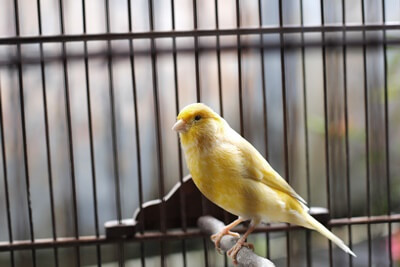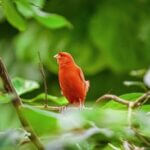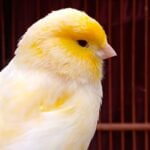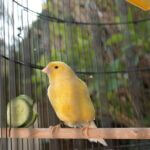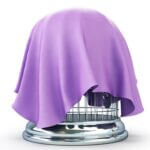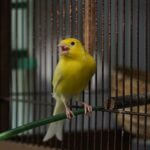Canaries are among the most popular songbirds, appearing in countless movies, cartoons, magazine articles, and social media posts. In most cases, pop culture depicts them as bright yellow.
This has led many people to believe that all canaries are yellow, but the serinus canaria species has a wide range of colors. It depends on the canary’s genetics and diet, but there are up to a dozen colors.
Are All Canaries Yellow?
No, not every canary is yellow. This is a diverse species with various colors, ranging from the stereotypical yellow to white, blue, green, red, and even dark brownish.
These color differences were brought about by centuries of selective breeding and artificial selection in Europe, Asia, and America.
According to the Archives of Natural History, the original canaries weren’t yellow but gray-green, and the yellow color only arrived in the years following 1610 A.D.
The cross-breeding combinations that brought on the yellow color are unknown. However, many researchers believe that the original cross-breeders in Germany and Italy mated the canaries with goldfinches, hoping to get a species that combined the singing abilities of the two.
The yellow color was simply an unintended consequence, albeit a welcome one. It made a new type of canary that was eye-catching and aesthetically pleasing.
What Colors are Canaries?
In regards to color, canaries are placed in two categories: melanin types and lipochrome types.
Melanic Canaries
As the name suggests, canaries in this group have a higher level of pigmentation in their plumage, so they appear darker than other canaries.
Birds under this classification include brown and black canaries and hybrids with darker appearances. Melanic canaries are rare, as most people looking for canaries value the eccentric colors (yellow and red) over the darker hues.
Ironically, the original canaries, now personified by the green wild canaries of today, had a melanin phenotype.
Lipochrome Canaries
These canaries lack melanin pigmentation and are a lighter color. They’re mainly a product of centuries of cross-breeding; some are mutations of the melanic types.
Lipochromes are divided into five distinct kinds based on the color variations in their feathers and eyes:
- Intense Lipochromes: The feathers have a uniform color, whether red, white, or yellow.
- Mosaic Lipochrome: Mosaic canaries have a uniform feather color, but the intensity is stronger in some areas. There are also dark spots or smears on the feathers.
- Ivory Lipochrome: These also have uniform color across the body. However, the colors aren’t intense and mostly include pinkish and ivory-yellowish hues.
- Snowy Lipochrome: The color is uniform but fades toward the edges, with the faded parts appearing almost white.
- Ocular Lipochromes: These canaries have colored eyes due to inhibited melanin production. Consequently, the same lipochromes in the feathers take the melanin’s place in the eyes.
Beyond the general classification, there are three ocular lipochromes, such as:
- Lutino – They have both yellow ground color and yellowish eyes. They’re direct descendants of the green, wild canary and compose most of the canaries sold as pets.
- Rubino – Also known as red canaries, or red-factor canaries, rubinos are characterized by a dark red feather color and red eyes. Some birds’ eyes aren’t as red as the feathers and may appear pinkish.
- Albino – These are often pure white due to a complete lack of melanin. Their eyes are usually pink, but red eyes are not uncommon. Notably, albino canaries are extremely rare, as they come about due to mutations in the red lipochrome that prevent them from making any melanin at all.
Unique Canary Colors
Although yellow and white albino canaries are more common, few owners have ever come across red or green ones. They’re rare and usually bred for different reasons, usually for their songs.
Here’s an assessment of the more unique canary colors:
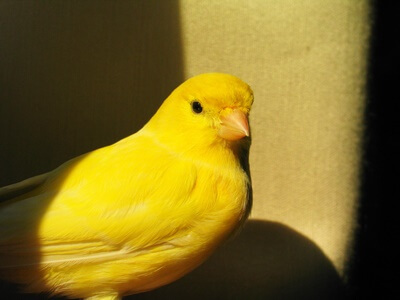
Green Canary
Wild canaries are a combination of green and yellow (which sometimes appear gray-greenish) and have a great deal of brown pigmentation.
Depending on their native continent, green canaries will have dark streaks running across their feathers, making them appear distinct from domestic canaries.
Most people seeing one for the first time would assume the two animals are from different species.
The green canaries are popular among the more nostalgic section of the avian community, as they represent the ‘pure’ canary. They are also highly regarded for their song, as well as their stamina and energy while singing.
However, you’re less likely to find a green canary at your local bird store, as they’re more expensive and harder to handle than the regular yellow breeds.
Red-Factor Canaries
Despite being called red canaries, they’re technically not pure canaries. Current Biology shows they’re a cross-breed between common canaries and red siskin birds.
Due to further cross-breeding within the subspecies, some red factors are fully red from head to toe; others are more orange than red, and others still are red but have black heads and black streaks on their wings.
Avoid red factors if you love a singing canary, as they usually lack singing talent. However, red canaries are pretty, and you can determine how red they become by giving them certain foods.
What Determines a Canary’s Color?
These three factors influence the canary’s final look:
Genetics
The primary determinant of color in canaries is genetics. In particular, the phenotype denotes the actual appearance of a bird, while the genotype indicates the possible colors of its offspring.
Each canary has two sets of genes taken from both its parents. So, a canary with two parents of the same color (two similar genotypes) will take the parent’s color.
On the other hand, a canary with two different genes – one for lipochrome and another for melanin – will most likely be streaked or variegated.
However, if you mate two variegated birds, there’s only a 50% chance of them producing variegated offspring. There’s a big possibility that 25% of the offspring will be clear, and the other 25% will be dark.
Diet
In melanic canaries, color intensity is driven more by diet than genetics. This is especially so for red canaries, which can go from dark red to orange to rosy pink within a few weeks.
According to The Wilson Journal of Ornithology, red-factors deposit more dietary carotenoids in their feathers than yellow canaries. This leads to visible changes in feather colors when they’re continuously fed bright-colored foods, like:
- Cherries
- Carrots
- Beets
- Cayenne pepper
Grooming
The level of dirt and grime on your canary’s feathers can further alter its color, albeit slightly.
According to Animal Behaviour, males with dirtier feathers had deep and distinguishable coloration for hours, appearing more intense in the shoulders and throat.
However, unless your canary’s bedding is made of loose soil, there’s little chance it’ll get dirty enough to affect its color sufficiently.

